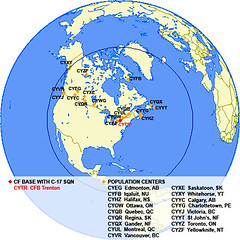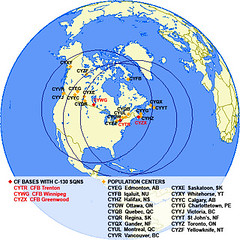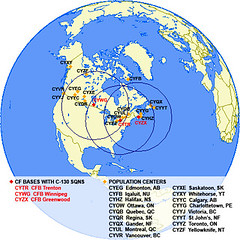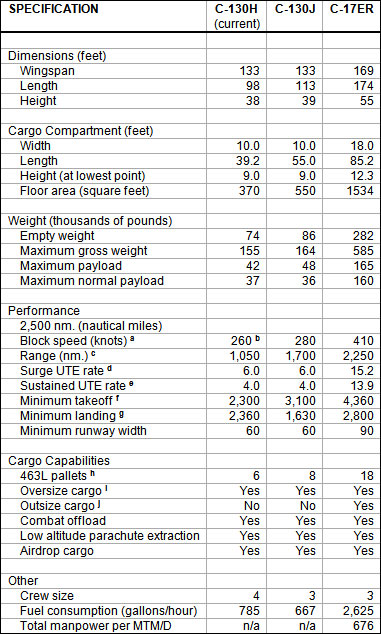CTV journalist
David Akin posed a question to the Torch gang about whether it would be possible for Boeing (prime contractor for the C-17 Globemaster III strategic airlifter) to “win a trifecta” by not only securing DND’s strat-lift and rotary-wing heavy lift contracts, but the tac-lift contract as well.
I responded via e-mail to Mr. Akin, but will post some of that content here by way of answering the question for our readers. I am a big believer in the C-17’s capabilities and have in the past argued for total replacement of the 130 force by 17s, but have since reconsidered. Such a move is not completely out of left field, but given the CF’s usual mission profile, a balance between the two (strat-lifters and tac-lifters) is best.
First some background on the variables in air mobility. The payload an aircraft can carry is a function of many factors, most obvious being the distance to the destination. The weight of the aircraft’s structure, fuel, and payload affect its range, as well as prevailing weather conditions along the planned flight route. Since the weight of the aircraft structure and its maximum takeoff weight (MTOW) are static, the variables are fuel and payload. Carrying more fuel than payload permits greater range but sacrifices payload capacity; carrying more payload cuts down on the aircraft’s range.
C-17A GLOBEMASTER III
A high-wing, four-engine, turbofan-powered, T-tailed military transport designed for long-range (strategic) airlift with integral short field/rough field tactical capability. Primary mission is to rapidly deliver troops and cargo to main operating bases or directly to forward bases in a deployed area. Can also perform theatre (tactical) airlift missions when required. The current production model C-17ER has an unrefueled, zero-payload range of 6,200 nautical miles while the original C-17 can travel 4,600 nautical miles. The C-17ER weighs 2,500 pounds more than the C-17, and the maximum operational payloads differ by the same amount (164,900 pounds for the C-17ER, 167,400 pounds for the C-17).
Both models have a range of 2,250 nautical miles with maximum payload, and MTOW for both is 585,000 pounds. At distances greater than 3,250 nautical miles, the C-17ER can carry heavier payloads than the C-17; using the standard planning load of 90,000 pounds, the C-17ER can travel 650 nautical miles further (4,250 versus 3,600 nm) than the C-17.
Figure 1. C-17ER 2,250 nm range w/max normal payload from proposed home field (CFB Trenton, [CYTR])

(click on image to enlarge)
C-130E/H/J HERCULES
A turboprop-powered, four-engine, high-wing military transport primarily used as short-range (tactical or intratheater) airlifter. The latest stretched version of the C-130J (formerly known as the C-130J-30 and CC-130J) has a fuselage 180 inches longer than that of previous models. Changes to the J-model’s cargo compartment include a built-in winch and the ability to make the floor flat for vehicles / non-palletised loads by using flip-over roller trays like those on the C-17.
Figure 2. C-130J 1,700 nm range w/max normal payload from proposed home fields (CFB Winnipeg [CYWG], CFB Trenton [CYTR], CFB Greenwood [CYZX])

(click on image to enlarge)
Maximum takeoff weight of the older E/H models is 153,700 pounds. The Herc can also be armored to protect the aircrew and critical systems against hostile fire; armour adds 1,569 pounds to the C-130’s empty weight and also affects its center of gravity. An armoured E/H-model Herc can still carry a maximum payload of 42,000 pounds, but carrying such mass drastically reduces range. An unarmored E/H Herc can transport 42,000 pounds to a distance of 260 nautical miles, whereas an armoured E/H Hercules carrying a 42,000 pound payload can travel only 60 nautical miles.
Figure 3. C-130E (current CF inventory) 1,000 nm range w/max normal payload from home fields (CFB Winnipeg [CYWG], CFB Trenton [CYTR], CFB Greenwood [CYZX])

(click on image to enlarge)
Additionally, when carrying payloads greater than 36,500 pounds, a C-130 must land with at least 6,000 pounds of fuel in the wing tanks in order to reduce stress on the wing attachment points. The heavier the payload, the greater the amount of reserved wing fuel, resulting in a corresponding decrease in aircraft range. When carrying a payload of 40,000 pounds, the C-130 must retain 19,400 pounds in the wing tanks for stress relief. This fuel must remain in the wing tanks until the cargo has been offloaded.
SIDE-BY-SIDE COMPARISON
Concept and some artwork from "The C-17 Transport -- Joint Before Its Time", Joint Forces Quarterly, No. 12 [Summer 1996], pp 69-73. Some figures updated by me.
(click on image to enlarge)
Figure 4. Characteristics of Canadian Military Transport Aircraft

SOURCES:
C-130E/H aircraft specifications from "Improving Strategic Mobility: The C-17 Program and Alternatives", CBO Study, September 1986.
C-130J aircraft specifications from Lockheed-Martin's c-130j.ca website.
C-17ER aircraft specifications from the "Report of the Defense Science Board Task Force on Mobility, September 2005.
NOTES:
a Average speed over a 2,500 nm range, including time spent in takeoff, climb to cruising altitude, approach and landing.
b 1,500 nm block speed for C-130H.
c Maximum range with maximum normal payload and standard AMC fuel reserves.
d Objective utilisation rate (UTE): Average number of hours per day that the primary aircraft inventory flies. Surge utilisation is the most demanding period during the first 45 days of wartime operations, when air mobility planners expect the highest demand for airlift resources.
e After a 45 day surge operation in wartime, the immediate demand for airlift decreases somewhat and a greater percentage of needed equipment arrives by ship. This lower operational tempo is known as a sustained UTE rate.
f With maximum payload for 2.25g maneuver load factor and maximum fuel.
g Critical field length, sea level, ISA conditions.
h 463L pallet system: bulk cargo system in use in by the USAF, RAF, CF and other NATO air forces for loading efficiency and space/weight optimisation aboard transport aircraft. 463L pallets are 7.3 feet long x 9 feet wide, to a maximum height of 8 feet.
i Oversize cargo: Second classification of bulk cargo, larger than bulk/463L dimensions. Oversize cargo is palletised with a height exceeding 8 feet, or cargo with maximum dimensions of 9.1 feet in length, 9.75 feet in width, and 8.75 feet in height.
j Outsize cargo: Largest classification of bulk cargo, exceeding the dimensions of oversize cargo and requiring a C-17 or C-5 for transport.
As the chart and tables indicate, a C-130J can, with maximum payload, depart from and arrive at a smaller airstrip than a C-17ER with maximum payload. Keep in mind though, that the 130J carries about one-quarter the payload of a C-17ER (roughly 36,000lbs max normal payload for a 130J whereas the 17ER carries 160,000 max normal). Both aircraft can exceed max normal weights for specific mission profiles.
Boeing's specs say the 17's minimum landing distance with a 160,000lb payload is 3,000ft -- assuming the field is at sea level with normal sea-level air pressure and temperature -- these factors will affect the length of takeoff/landing rolls for any aircraft. A C-130J's landing distance with max normal payload is also around 3,000ft, but it can be shaved down in exceptional circumstances (usually wartime) to about 1600ft if using "max effort" -- reverse thrust, spoilers, maximum braking and delaying nosewheel touchdown (keeping more of the airframe in the airflow for longer periods of time helps brake the aircraft faster). The 17 can similarly perform a max effort landing but because it is a much bigger bird, and carries much greater mass and volume, it is still limited to around 2,800ft. So at the end of the day the 130J-30 can, if pressed, hit a smaller airstrip.
Of course if you limited the C-17 to the C-130's max cargo weight, it would be able to arrive and depart in similar takeoff/landing distances, but it would also cost more to get it there. When hefting large volumes, the C-17 wins hands down because it can deliver a much larger payload across longer distances for less cost. But when the payloads and airstrips get smaller, at a certain point the 130J becomes the more cost-efficient delivery system. There are metrics the transport planners use such as cost-per-payload-pound. This figure varies per aircraft type, depending on their resource and maintenance requirements. One must factor in not just getting the payload to the destination, but the extra expenses of ground maintenance, fuel costs, aircrew costs, etc. To use a somewhat down-to-earth example, consider truck rentals. If you had to move the contents of your house to a new house on the other side of town, then going to Budget and renting a 26ft truck is not a bad idea. Long distance, high capacity, eliminates multiple trips to the same destination -- makes sense. If on the other hand you are just moving say a computer, chair and desk across town, then perhaps an ordinary van is better. You can still carry the computer, chair and desk in the 26ft truck, but it would cost you a lot more than just renting a van.
Another problem has to do with the nature of the airfields themselves. While the C-17 can deliver payloads to dirt airstrips like a C-130, it can not do so continuously. C-17s can deliver cargo to concrete runways continuously, but can deliver to a dirt runway once or possibly twice because of the inherent properties of dirt. Because of its great mass, the wheels of the aircraft cut into the surface of the airstrip and leave a rut. The more arrivals and departures the C-17 makes, the more ruts and general wear and tear it produces on the dirt airfield -- until it finally becomes unusable. C-130s on the other hand are much lighter even at maximum landing weight, and can usually provide continuous service to unprepared dirt airstrips.
Then there’s unit cost. A C-17ER quite a bit more expensive than the C-130J (on the order of about 250% more expensive) so we'd be buying fewer C-17s; we couldn't replace the aging 130E/Hs on a one-for-one basis. Now you might think that this is not a bad thing, as the 17ER can carry four times the cargo. This is only a benefit, however, if all of the cargo has to go to the same place; then the C-17 is exactly what the doctor ordered. If you routinely have a variety of missions that requires cargo to go to geographically disparate locations on the same day, then having fewer but higher-capacity birds is not so great; you'd rather have more aircraft, even lower-capacity ones, to hit those multiple destinations within your allotted time window. To use the truck analogy once more, if you have to move multiple computers, chairs and desks across town to multiple destinations all with an arrival time of 9am, then a single 26ft truck is out of the question. You need a fleet of vans to accomplish the mission.
The final limiting factor is training. If we were to transition to an all-17 fleet we would have to train a pile of aircrews and ground crews quickly. Boeing’s assembly line can crank out 15 C-17ERs a year, but the CF cannot crank out three or four fully mission capable aircrews and ground crews for each aircraft in a year. The USAF, for instance, plans to have two active aircrews per C-130, and five aircrews (three active, two reserve) per C-17. All of our C-130 aircrews, maintainers and instructors would need training on the new aircraft, new avionics and systems, new maintenance requirements and procedures, new handling procedures, new loading configurations, safety requirements, and so on. That will take a bit of time to ramp up. Training already-certified C-130E/H aircrews/ground crews on a 130J variant is not going to be a quantum leap requiring nearly as much time as training them up to an entirely new aircraft.
Since Canada's warfighting and peacekeeping will most certainly be fought away from home, there *is* a logistical need for strategic airlift. But there is also a need for tactical airlift, to get smaller payloads into smaller airstrips in a cost-efficient way.
Cross-posted to Taylor & Company

















